Explore the universe and discover our home planet with the official NASA Tumblr account
Don't wanna be here? Send us removal request.
Text

This week, get caught in the spider’s web.
Check out the incredibly detailed view our Hubble Space Telescope captured of the Tarantula Nebula! This cosmic spider resides in the Large Magellanic Cloud, a dwarf galaxy located about 160,000 light-years away in the constellations Dorado and Mensa. The Tarantula Nebula is the largest and brightest star-forming region, not just in the Large Magellanic Cloud, but in the entire group of nearby galaxies to which the Milky Way belongs. It's also home to the most massive stars known, some roughly 200 times as massive as our Sun.
Make sure to follow us on Tumblr for your regular dose of space!
4K notes
·
View notes
Text
Cosmic Dawn through Her Lens: Sophia Roberts
If you’ve seen video footage of the James Webb Space Telescope, there’s a good chance you’ve seen it through her lens.
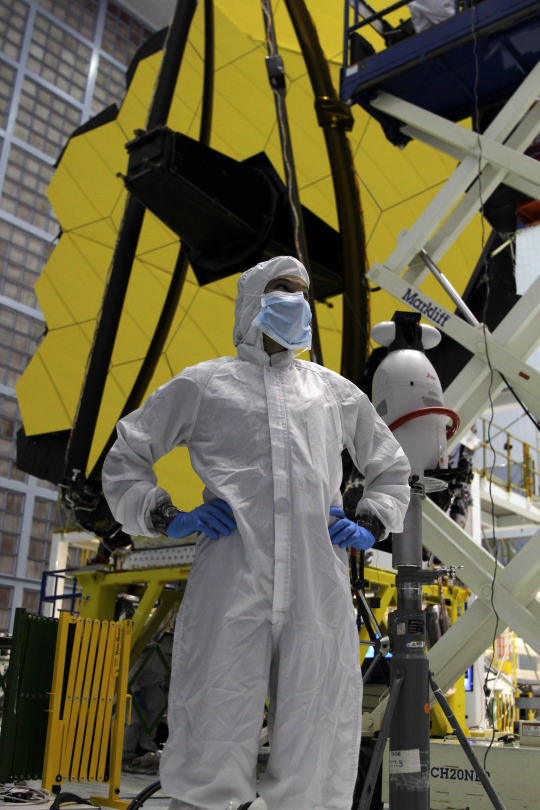
Sophia Roberts is an astrophysics video producer at NASA Goddard in Maryland. She spent years chasing Webb around the country as one of its primary videographers, documenting its construction and crafting stories that explained why Webb was worth building.
“There were countless potential points of failure. It was up to the communications team to acknowledge those risks honestly and help the public understand why the mission still mattered,” she said.

Sophia’s incredible efforts included capturing hours-long timelapses of major operations, filming inside clean rooms (special facilities where space mission components are assembled and tested), and editing these moments together, bringing the public on Webb’s journey with her. Sophia also tracked down the origins of many of the elements used to create Webb. She was even able to visit and film a beryllium mine, home to the rare metal from which Webb’s mirrors originated.
“Seeing this raw, elemental starting point for something as refined as a space telescope was unforgettable,” Sophia said.

What kept her going was her own curiosity, wondering: Why are the mirrors exposed? Why are they gold? What makes beryllium special? Why is the radiator black?
When Webb was transported via boat from the Port of Los Angeles to French Guiana (the telescope was too heavy to travel by bridge and too large for a plane), Sophia was there too! She rented a chase boat to follow Webb and film its journey.
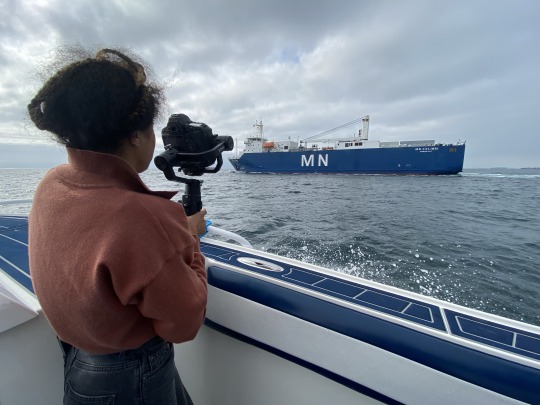
“Chasing Webb down the California coast at full speed felt like an action movie; and it was the last time we’d ever see it on U.S. soil,” she said.
Leading up to the telescope’s launch, the necessary work became more and more intense…and then launch! and it was done. It took a while to shake the “void” that the job had left behind.
Sophia and her team won several Webbys for their work, recognizing them for their social media campaigns, live broadcasts covering the launch, deployment, and first images, as well as a short film called 29 Days on the Edge, diving into the arduous process of unfolding Webb in space over a month after launch.
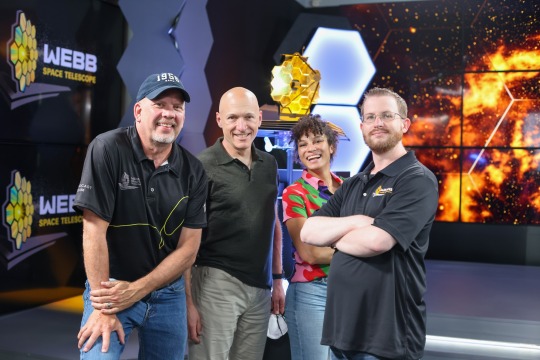
Sophia is one of the stars of our newest NASA+ documentary, Cosmic Dawn, which takes you behind the scenes of the world’s most powerful space telescope. See the story through her lens: https://www.nasa.gov/cosmicdawn/.
Make sure to follow us on Tumblr for your regular dose of space!
#NASA#James Webb Space Telescope#astrophotography#film#documentary#space#telescope#technology#tech#astrophysics#photography
1K notes
·
View notes
Text
Fourth of July from Way Up High! 🎆
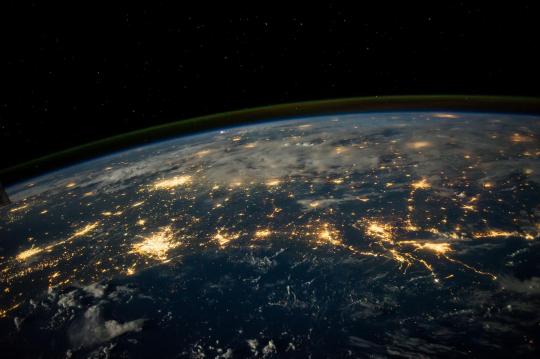
Ever wondered what a firework might look like from the sky?
Astronauts aboard the International Space Station (ISS) get front-row seats to some of the best light shows on Earth—city lights, lightning storms, auroras, and yes, even fireworks. Check out the view!
One of the Expedition 40 crew members aboard the ISS photographed this Aug. 9, 2014, nighttime image showing city lights in the southern United States from some 225 miles above Earth.
Stay curious, stay safe, and keep looking up. Happy Independence Day from all of us at NASA! 🎇
#Fourth of July#Independence Day#NASA#ISS#view from space#Earth at night#space photography#International Space Station
1K notes
·
View notes
Text
Space Rocks!🤘But Also ️Space Rocks!☄️

Asteroids: they’re ancient, rocky, and way cooler than you might think. June 30 is International Asteroid Day, a global event to raise awareness about asteroids and what we’re doing to study them. Here’s why we’re obsessed with them (and why you should be, too).
What are asteroids?
Asteroids are leftover building blocks from the early solar system, orbiting the Sun like planetary time capsules. Most hang out in the main asteroid belt between Mars and Jupiter, but some—called Near-Earth Objects, or NEOs—orbit closer to home. They range in size from 329 miles (530 kilometers) in diameter to less than 33 feet (10 meters) across.
Why do we study them?
Studying asteroids helps us unlock the origins of our solar system.
In 2023, our OSIRIS-REx mission collected a sample from asteroid Bennu that could reveal whether asteroids delivered water and other ingredients for life when they collided with Earth billions of years ago.

Lucy in the sky…with asteroids? Our Lucy mission, which launched in 2021, is named for a fossilized skeleton of a human ancestor, which was in turn named for the Beatles song “Lucy in the Sky with Diamonds.” Lucy is the first mission to explore asteroids that share an orbit around the Sun with Jupiter.
A timelapse of the asteroid Donaldjohanson taken on NASA’s Lucy spacecraft. The images, captured approximately every 2 seconds beginning at 1:50 p.m. EDT April 20, 2025, show a white, irregular, elongated shape rotating slowly. Its surface is covered in small craters and has a rough, uneven texture. The asteroid appears bright against a black background. Credit: NASA/Goddard/SwRI/Johns Hopkins APL
What if an asteroid hits Earth?
NASA’s Planetary Defense Program uses telescopes to keep an eye out for asteroids and other NEOs, in case any get too close for comfort. Although a catastrophic collision is highly unlikely for the next 100 years or more, the telescopes detect smaller objects on a collision course with Earth a few times per year. No need to worry—these objects are just a few feet (meters) in size and cause no damage.
youtube
Rock on!
Hungry for more? Check out our asteroid portal for a cosmic crash course, or explore a real-time visualization of every known asteroid and comet classified as an NEO with NASA’s Eyes on Asteroids app.
Make sure to follow us on Tumblr for your regular dose of space!
#International Asteroid Day#asteroids#NASA#planetary defense#space rocks#outer space#fun facts#rock on#science#Youtube
2K notes
·
View notes
Text

Happy summer solstice, Northern Hemisphere!
The summer solstice – the beginning of astronomical summer – falls on June 20, 2025 (June 21 UTC). It’s the longest day of the year and marks the change of seasons. For our friends in the Southern Hemisphere, it’s the shortest day of the year and the beginning of winter.
Earth orbits at an angle, so half the year, the Northern Hemisphere is tilted toward the Sun — this is summer in the Northern Hemisphere, and winter in the Southern Hemisphere. The other half of the year, the Northern Hemisphere is tilted away from the Sun, creating winter in the north and summer in the south. Solstices happen twice per year, at the points in Earth’s orbit where this tilt is most pronounced.
How do you plan on spending the longest (or shortest) day of the year? 😎
3K notes
·
View notes
Text

What does it take to see this?
Decades of dreamers, inventors, scientists and artists working together to create a labor of love: a telescope capable of peering deep into the universe and back through time.
The James Webb Space Telescope has allowed us to see the earliest galaxies, the auroras and rings on our gas giants, and even detect clouds on planets far beyond our solar system, all because a group of dreamers looked at the universe with curiosity.
Witness the incredible story of Webb’s journey – from an impossible idea to a scientific marvel – all through the eyes of the people who made it possible in our new documentary. Cosmic Dawn is streaming now on NASA+.
#NASA#James Webb Space Telescope#astrophotography#space photography#space#galaxies#documentary#film#astronomy#engineering#technology#tech
4K notes
·
View notes
Text

Zero Gravity Indicators: Plushies in Space!
What are zero gravity indicators?
Did you know that some astronauts bring stuffed animals with them on their journeys to space? A zero gravity indicator (ZGI) is a plushie that is brought aboard spacecraft to demonstrate when the astronauts have reached the weightlessness of space. Even though the astronauts are strapped in their seats, the plushie will float — and viewers of the livestream will know they’ve reached space! Read on to learn about some of the plushies astronauts have taken with them to space.
Giraffiti

NASA astronaut and Artemis II commander Reid Wiseman brought a very special ZGI to the International Space Station: a toy giraffe named Giraffiti. Wiseman’s mother gifted Giraffiti to his oldest daughter when she was born. When Wiseman embarked on his first mission to space, his kids gave him Giraffiti to take with him to space.
Dinosaur

NASA astronaut Karen Nyberg made a stuffed dinosaur toy by sewing together scraps of food-packaging liners and a T-shirt. Although this dinosaur toy was not an official zero gravity indicator that didn’t stop it from floating around the International Space Station and being very cute for the cameras!
8-Ball

NASA astronaut and Artemis II mission specialist Christina Koch brought a plush 8-ball toy with her during her stay aboard the International Space Station in 2019. The toy represented the Astronaut Class of 2013, which was affectionately called the “8-balls” because of its eight members. Both NASA astronauts Nick Hague and Jessica Meir, pictured here, were members of this class.
Crane
NASA's SpaceX Crew-10 mission astronauts chose a plush origami crane as their zero gravity indicator because they are all pilots and grew up building paper airplanes. The crane is also a symbol of peace.
Cheburashka and Chimpo
youtube
English captions are available for the video.
When NASA astronaut Frank Rubio flew to the International Space Station in 2022, his cosmonaut crewmates brought aboard a stuffed animal named Cheburashka. Rubio also carried a small stuffed animal in his pocket named Chimpo. Chimpo was a stuffed animal that Rubio’s children had for almost 20 years before giving it to Rubio for him to bring aboard his flight.
Snoopy

Snoopy hitched a ride around the Moon aboard the Orion spacecraft during the Artemis I mission in 2022. Although this mission didn’t have astronauts, Snoopy was joined by a manikin named Moonikin Campos who was used to measure vibrations inside the capsule. NASA has shared an association with Snoopy since the Apollo era, when Charles M. Schulz Schulz created comic strips of Snoopy on the Moon, capturing public excitement about America’s achievements in space.
What would you take with you to space?
Now it’s your turn! People of all ages from all over the world have the opportunity to design the zero gravity indicator for the Artemis II mission around the Moon. Should the astronauts’ plush companion have wings? Scales? What would you like to see floating around the Orion spacecraft? Check out the Moon Mascot challenge to learn more! Submissions are due June 16, 2025.
#art#design#plushie#Moon#space#makers#tech#technology#NASA#Artemis#crochet#sewing#stuffed animals#kidcore#amigurumi#YouTube
4K notes
·
View notes
Text
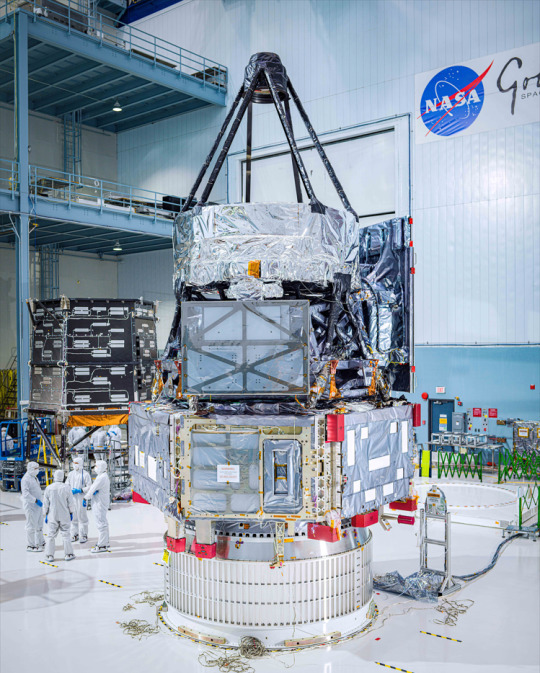
One of the two assembled critical sections of NASA’s Nancy Grace Roman Space Telescope in the cleanroom at NASA’s Goddard Space Flight Center in Greenbelt, Maryland. This assembly consists of Roman’s optics, primary science instruments, and spacecraft bus.
Happy Birthday, Dr. Nancy Grace Roman!
Today marks what would have been the 100th birthday of Dr. Nancy Grace Roman — NASA’s first chief astronomer and the namesake for NASA’s nearly complete Nancy Grace Roman Space Telescope.
Dr. Roman championed NASA’s Hubble Space Telescope and paved the way for other major space-based telescopes like NASA’s James Webb Space Telescope and now the upcoming Roman telescope — currently assembled into two large structures technicians will soon connect.
Key assessments at NASA’s Goddard Space Flight Center in Greenbelt, Maryland are ensuring that both Roman’s critical sections are ready for integration and additional tests as a complete observatory. Having recently passed a space environment test, Roman remains on schedule for launch by May 2027, with the team aiming for launch as early as fall 2026.
Learn more about Dr. Roman and stay up to date on the mission at nasa.gov/roman.
Make sure to follow us on Tumblr for your regular dose of space!
#NASA#Nancy Grace Roman Space Telescope#birthday#astronomy#engineering#technology#tech#Nancy Grace Roman#space
1K notes
·
View notes
Text
Seeing the Invisible Universe
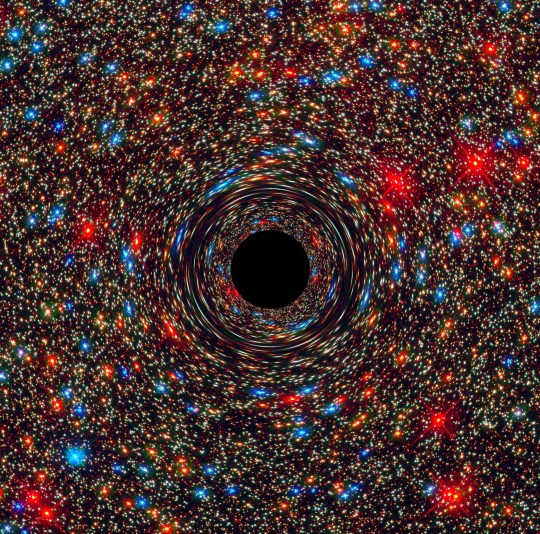
This computer-simulated image shows a supermassive black hole at the core of a galaxy. The black region in the center represents the black hole’s event horizon, beyond which no light can escape the massive object’s gravitational grip. The black hole’s powerful gravity distorts space around it like a funhouse mirror. Light from background stars is stretched and smeared as it skims by the black hole. You might wonder — if this Tumblr post is about invisible things, what’s with all the pictures? Even though we can’t see these things with our eyes or even our telescopes, we can still learn about them by studying how they affect their surroundings. Then, we can use what we know to make visualizations that represent our understanding.
When you think of the invisible, you might first picture something fantastical like a magic Ring or Wonder Woman’s airplane, but invisible things surround us every day. Read on to learn about seven of our favorite invisible things in the universe!
1. Black Holes

This animation illustrates what happens when an unlucky star strays too close to a monster black hole. Gravitational forces create intense tides that break the star apart into a stream of gas. The trailing part of the stream escapes the system, while the leading part swings back around, surrounding the black hole with a disk of debris. A powerful jet can also form. This cataclysmic phenomenon is called a tidal disruption event.
You know ‘em, and we love ‘em. Black holes are balls of matter packed so tight that their gravity allows nothing — not even light — to escape. Most black holes form when heavy stars collapse under their own weight, crushing their mass to a theoretical singular point of infinite density.
Although they don’t reflect or emit light, we know black holes exist because they influence the environment around them — like tugging on star orbits. Black holes distort space-time, warping the path light travels through, so scientists can also identify black holes by noticing tiny changes in star brightness or position.
2. Dark Matter

A simulation of dark matter forming large-scale structure due to gravity.
What do you call something that doesn’t interact with light, has a gravitational pull, and outnumbers all the visible stuff in the universe by five times? Scientists went with “dark matter,” and they think it's the backbone of our universe’s large-scale structure. We don’t know what dark matter is — we just know it's nothing we already understand.
We know about dark matter because of its gravitational effects on galaxies and galaxy clusters — observations of how they move tell us there must be something there that we can’t see. Like black holes, we can also see light bend as dark matter’s mass warps space-time.
3. Dark Energy

Animation showing a graph of the universe’s expansion over time. While cosmic expansion slowed following the end of inflation, it began picking up the pace around 5 billion years ago. Scientists still aren’t sure why.
No one knows what dark energy is either — just that it’s pushing our universe to expand faster and faster. Some potential theories include an ever-present energy, a defect in the universe’s fabric, or a flaw in our understanding of gravity.
Scientists previously thought that all the universe’s mass would gravitationally attract, slowing its expansion over time. But when they noticed distant galaxies moving away from us faster than expected, researchers knew something was beating gravity on cosmic scales. After further investigation, scientists found traces of dark energy’s influence everywhere — from large-scale structure to the background radiation that permeates the universe.
4. Gravitational Waves

Two black holes orbit each other and generate space-time ripples called gravitational waves in this animation.
Like the ripples in a pond, the most extreme events in the universe — such as black hole mergers — send waves through the fabric of space-time. All moving masses can create gravitational waves, but they are usually so small and weak that we can only detect those caused by massive collisions. Even then they only cause infinitesimal changes in space-time by the time they reach us. Scientists use lasers, like the ground-based LIGO (Laser Interferometer Gravitational-Wave Observatory) to detect this precise change. They also watch pulsar timing, like cosmic clocks, to catch tiny timing differences caused by gravitational waves.
This animation shows gamma rays (magenta), the most energetic form of light, and elusive particles called neutrinos (gray) formed in the jet of an active galaxy far, far away. The emission traveled for about 4 billion years before reaching Earth. On Sept. 22, 2017, the IceCube Neutrino Observatory at the South Pole detected the arrival of a single high-energy neutrino. NASA’s Fermi Gamma-ray Space Telescope showed that the source was a black-hole-powered galaxy named TXS 0506+056, which at the time of the detection was producing the strongest gamma-ray activity Fermi had seen from it in a decade of observations.
5. Neutrinos

This animation shows gamma rays (magenta), the most energetic form of light, and elusive particles called neutrinos (gray) formed in the jet of an active galaxy far, far away. The emission traveled for about 4 billion years before reaching Earth. On Sept. 22, 2017, the IceCube Neutrino Observatory at the South Pole detected the arrival of a single high-energy neutrino. NASA’s Fermi Gamma-ray Space Telescope showed that the source was a black-hole-powered galaxy named TXS 0506+056, which at the time of the detection was producing the strongest gamma-ray activity Fermi had seen from it in a decade of observations.
Because only gravity and the weak force affect neutrinos, they don’t easily interact with other matter — hundreds of trillions of these tiny, uncharged particles pass through you every second! Neutrinos come from unstable atom decay all around us, from nuclear reactions in the Sun to exploding stars, black holes, and even bananas.
Scientists theoretically predicted neutrinos, but we know they actually exist because, like black holes, they sometimes influence their surroundings. The National Science Foundation’s IceCube Neutrino Observatory detects when neutrinos interact with other subatomic particles in ice via the weak force.
6. Cosmic Rays

This animation illustrates cosmic ray particles striking Earth's atmosphere and creating showers of particles.
Every day, trillions of cosmic rays pelt Earth’s atmosphere, careening in at nearly light-speed — mostly from outside our solar system. Magnetic fields knock these tiny charged particles around space until we can hardly tell where they came from, but we think high energy events like supernovae can accelerate them. Earth’s atmosphere and magnetic field protect us from cosmic rays, meaning few actually make it to the ground.
Though we don’t see the cosmic rays that make it to the ground, they tamper with equipment, showing up as radiation or as “bright” dots that come and go between pictures on some digital cameras. Cosmic rays can harm astronauts in space, so there are plenty of precautions to protect and monitor them.
7. (Most) Electromagnetic Radiation

The electromagnetic spectrum is the name we use when we talk about different types of light as a group. The parts of the electromagnetic spectrum, arranged from highest to lowest energy are: gamma rays, X-rays, ultraviolet light, visible light, infrared light, microwaves, and radio waves. All the parts of the electromagnetic spectrum are the same thing — radiation. Radiation is made up of a stream of photons — particles without mass that move in a wave pattern all at the same speed, the speed of light. Each photon contains a certain amount of energy.
The light that we see is a small slice of the electromagnetic spectrum, which spans many wavelengths. We frequently use different wavelengths of light — from radios to airport security scanners and telescopes.
Visible light makes it possible for many of us to perceive the universe every day, but this range of light is just 0.0035 percent of the entire spectrum. With this in mind, it seems that we live in a universe that’s more invisible than not! NASA missions like NASA's Fermi, James Webb, and Nancy Grace Roman space telescopes will continue to uncloak the cosmos and answer some of science’s most mysterious questions.
Make sure to follow us on Tumblr for your regular dose of space!
4K notes
·
View notes
Text

Artemis Astronauts Have Drills, Too!
Chances are, if you have ever spent time in a school or office building, you have experienced a fire drill. Well, astronauts practice emergency drills, too!

Since we began sending astronauts to space, we have used systems and drills to practice moving people safely away from the launch pad in the unlikely event of an emergency during the countdown to launch.

Early Mercury and Gemini programs in the 1960s used a launch escape system in the form of a solid rocket motor that could pull the astronauts to safety in the event of an emergency. However, this system only accounted for the astronauts, and not other personnel at the launch pad. NASA’s emergency systems have since improved substantially to include everyone.
youtube
Artemis II will be NASA’s first mission with crew aboard the SLS (Space Launch System) rocket and Orion spacecraft. Artemis II will fly around the Moon and come back to Earth. Beginning with the Artemis II mission, we will use a track cable to connect the mobile launcher — the ground structure that supports the rocket before and during launch — to the perimeter of the launch pad. Picture a gondola ski lift beginning at the top of the rocket and ending all the way down to the ground. In case of an emergency, astronauts and support crews move from the capsule into the crew access arm, climb into one of four baskets waiting for them, and ride down to the ground.

There, members of the Pad Rescue team are ready to scoop the astronauts up and whisk them to safety. Think of the Pad Rescue team as spaceflight knights in shining armor. Except instead of saving crew from a fire breathing dragon, they are whisking the astronauts away from a fully loaded skyscraper-sized rocket that’s getting ready to lift off.

The Artemis II mission will also introduce several new ground systems for the first time – including the new and improved braking system similar to what roller coasters use! Though no NASA mission to date has needed to use its ground-based emergency system during launch countdown, those safety measures are still in place and maintained as a top priority.
So the next time you practice a fire drill at school or at work, remember that these emergency procedures are important for everyone to stay safe — even astronauts.
Make sure to follow us on Tumblr for your regular dose of space!
2K notes
·
View notes
Text

Hubble Space Telescope: Exploring the Cosmos and Making Life Better on Earth
In the 35 years since its launch aboard space shuttle Discovery, the Hubble Space Telescope has provided stunning views of galaxies millions of light years away. But the leaps in technology needed for its look into space has also provided benefits on the ground. Here are some of the technologies developed for Hubble that have improved life on Earth.

Image Sensors Find Cancer
Charge-coupled device (CCD) sensors have been used in digital photography for decades, but Hubble’s Space Telescope Imaging Spectrograph required a far more sensitive CCD. This development resulted in improved image sensors for mammogram machines, helping doctors find and treat breast cancer.

Laser Vision Gives Insights
In preparation for a repair mission to fix Hubble’s misshapen mirror, Goddard Space Flight Center required a way to accurately measure replacement parts. This resulted in a tool to detect mirror defects, which has since been used to develop a commercial 3D imaging system and a package detection device now used by all major shipping companies.

Optimized Hospital Scheduling
A computer scientist who helped design software for scheduling Hubble’s observations adapted it to assist with scheduling medical procedures. This software helps hospitals optimize constantly changing schedules for medical imaging and keep the high pace of emergency rooms going.

Optical Filters Match Wavelengths and Paint Swatches
For Hubble’s main cameras to capture high-quality images of stars and galaxies, each of its filters had to block all but a specific range of wavelengths of light. The filters needed to capture the best data possible but also fit on one optical element. A company contracted to construct these filters used its experience on this project to create filters used in paint-matching devices for hardware stores, with multiple wavelengths evaluated by a single lens.
Make sure to follow us on Tumblr for your regular dose of space!

2K notes
·
View notes
Photo


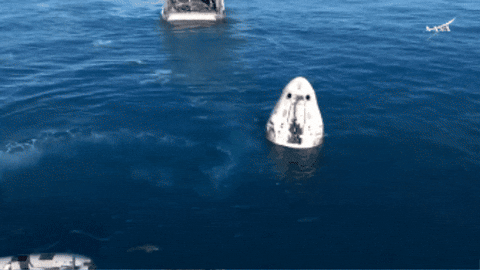

Dolphins x Astronauts: The collab we didn't know we needed
A pod of curious dolphins added extra meaning and porpoise to the recovery of Crew-9′s SpaceX Dragon capsule and its four explorers shortly after splashdown. Inside the capsule were astronauts Nick Hague, Suni Williams, Butch Wilmore, and cosmonaut Aleksandr Gorbunov, who splashed down off the coast of Florida at 5:57pm ET (2127 UTC) on March 18, 2025, concluding their scientific mission to the International Space Station. See Crew-9 return from deorbit to splashdown in this video. (The dolphins appear at 1:33:56.)
youtube
2K notes
·
View notes
Text
youtube
Moon Mascot Needed!
Have you ever wanted to design something that could fly around the Moon? This is your opportunity. The Artemis II astronauts will use a zero gravity indicator during their mission to demonstrate when the Orion spacecraft has reached microgravity. This plushie needs to be soft, small, and importantly, remind us of home. The Moon Mascot contest challenges people of all ages from all over the world to submit a design to be made by NASA’s Thermal Blanket Lab and flown aboard Artemis II. To submit a design for the contest, visit: freelancer.com/moon-mascot
#art#design#plushie#Moon#space#makers#tech#technology#NASA#Artemis#crochet#sewing#stuffed animals#kidcore#amigurumi#Youtube
2K notes
·
View notes
Text

Spinoffs: Space Station Innovations in Your Cart (and Heart!)
You might think NASA technology is just spaceships and telescopes, but did you know the camera in your cell phone is, too? It’s one of many NASA innovations now found everywhere on Earth.
The International Space Station has had crew living on it for 25 years straight. In that time, the space station has enabled a tremendous amount of research, helping NASA and scientists better understand long-term living in space – but it’s not just knowledge coming back down to Earth! Technologies developed for the space station and experiments conducted aboard the orbiting lab also benefit people on the planet below. Here are a few of these inventions, or spinoffs, you can find in your everyday life.

A Sunscreen That Blocks Radiation in Space – and on Your Face
After surviving for 18 months outside the International Space Station, an extremely hardy organism is now improving sunscreens and face cream products from a cosmetics company, which licensed use of the organism from NASA’s Jet Propulsion Laboratory.
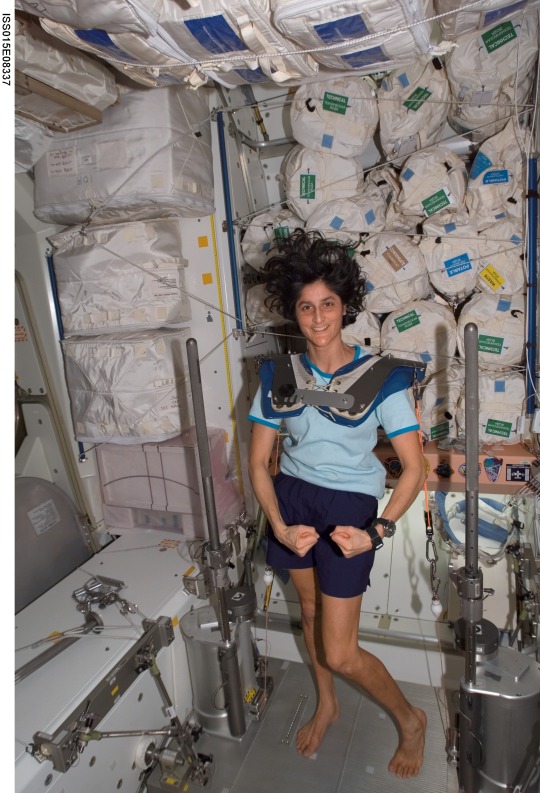

Build Muscle With or Without Gravity
Muscles atrophy quickly in space, so when astronauts began long stays on the International Space Station, they needed some specialized exercise equipment. A resistance mechanism made of a coiled metal spring formed the basis of the first way for astronauts to “lift weights” in space. Soon after, that same design became the heart of compact home gym equipment.

Fresh Greens Every Day of the Year
The need to grow fresh food in space pushed NASA to develop indoor agriculture techniques. Thanks to the agency’s research, private companies are building on NASA’s vertical farm structure, plant-growth “recipes,” and environmental-control data to create indoor farms, resulting in higher crop yields and better-quality produce while conserving water and energy and eliminating the need for pesticides.
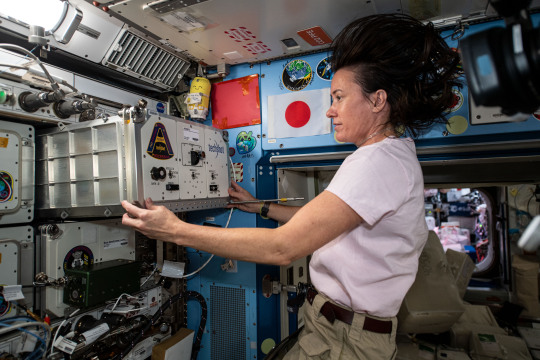
Cultivating Hearts and Knees in Space
Gravity is a significant obstacle to bioprinting cells and growing human tissue on Earth because heavier components settle to the bottoms of petri dishes. In the absence of gravity, each cell layer stays in place, which is how it’s possible to grow heart and knee tissue on the space station. The same principle also allows mixing of complex pharmaceuticals on orbit.

Storing Oodles of Energy
NASA chose nickel-hydrogen batteries to power the Hubble Space Telescope and the International Space Station because the technology is safe, reliable in extreme temperatures, and long-lived. NASA’s improvements brought down the cost of the technology, which is now used by large-scale utilities and renewable power plants that need to store energy generated by intermittent sources.
You can read about many more products sourced from the ISS on spinoff.nasa.gov.
Make sure to follow us on Tumblr for your regular dose of space!
2K notes
·
View notes
Text
5 Unpredictable Things Swift Has Studied (and 1 It’s Still Looking For)
Our Neil Gehrels Swift Observatory — Swift for short — is celebrating its 20th anniversary! The satellite studies cosmic objects and events using visible, ultraviolet, X-ray, and gamma-ray light. Swift plays a key role in our efforts to observe our ever-changing universe. Here are a few cosmic surprises Swift has caught over the years — plus one scientists hope to see.

#BOAT
Swift was designed to detect and study gamma-ray bursts, the most powerful explosions in the universe. These bursts occur all over the sky without warning, with about one a day detected on average. They also usually last less than a minute – sometimes less than a few seconds – so you need a telescope like Swift that can quickly spot and precisely locate these new events.
In the fall of 2022, for example, Swift helped study a gamma-ray burst nicknamed the BOAT, or brightest of all time. The image above depicts X-rays Swift detected for 12 days after the initial flash. Dust in our galaxy scattered the X-ray light back to us, creating an extraordinary set of expanding rings.

Star meets black hole
Tidal disruptions happen when an unlucky star strays too close to a black hole. Gravitational forces break the star apart into a stream of gas, as seen above. Some of the gas escapes, but some swings back around the black hole and creates a disk of debris that orbits around it.
These events are rare. They only occur once every 10,000 to 100,000 years in a galaxy the size of our Milky Way. Astronomers can’t predict when or where they’ll pop up, but Swift’s quick reflexes have helped it observe several tidal disruption events in other galaxies over its 20-year career.

Active galaxies
Usually, we think of galaxies – and most other things in the universe – as changing so slowly that we can’t see the changes. But about 10% of the universe’s galaxies are active, which means their black hole-powered centers are very bright and have a lot going on. They can produce high-speed particle jets or flares of light. Sometimes scientists can catch and watch these real-time changes.
For example, for several years starting in 2018, Swift and other telescopes observed changes in a galaxy’s X-ray and ultraviolet light that led them to think the galaxy’s magnetic field had flipped 180 degrees.

Magnetic star remnants
Magnetars are a type of neutron star, a very dense leftover of a massive star that exploded in a supernova. Magnetars have the strongest magnetic fields we know of — up to 10 trillion times more intense than a refrigerator magnet and a thousand times stronger than a typical neutron star’s.
Occasionally, magnetars experience outbursts related to sudden changes in their magnetic fields that can last for months or even years. Swift detected such an outburst from a magnetar in 2020. The satellite’s X-ray observations helped scientists determine that the city-sized object was rotating once every 10.4 seconds.

Comets
Swift has also studied comets in our own solar system. Comets are town-sized snowballs of frozen gases, rock, and dust. When one gets close to our Sun, it heats up and spews dust and gases into a giant glowing halo.
In 2019, Swift watched a comet called 2I/Borisov. Using ultraviolet light, scientists calculated that Borisov lost enough water to fill 92 Olympic-size swimming pools! (Another interesting fact about Borisov: Astronomers think it came from outside our solar system.)

What's next for Swift?
Swift has studied a lot of cool events and objects over its two decades, but there are still a few events scientists are hoping it’ll see.
Swift is an important part of a new era of astrophysics called multimessenger astronomy, which is where scientists use light, particles, and space-time ripples called gravitational waves to study different aspects of cosmic events.

In 2017, Swift and other observatories detected light and gravitational waves from the same event, a gamma-ray burst, for the first time. But what astronomers really want is to detect all three messengers from the same event.
As Swift enters its 20th year, it’ll keep watching the ever-changing sky.
Keep up with Swift through NASA Universe on X, Facebook, and Instagram. And make sure to follow us on Tumblr for your regular dose of space!
2K notes
·
View notes
Text
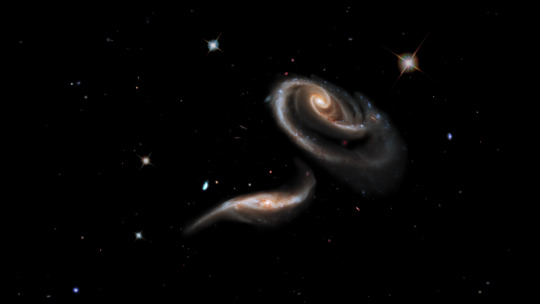
Love Letters from Space
Love is in the air, and it’s out in space too! The universe is full of amazing chemistry, cosmic couples held together by gravitational attraction, and stars pulsing like beating hearts.
Celestial objects send out messages we can detect if we know how to listen for them. Our upcoming Nancy Grace Roman Space Telescope will help us scour the skies for all kinds of star-crossed signals.
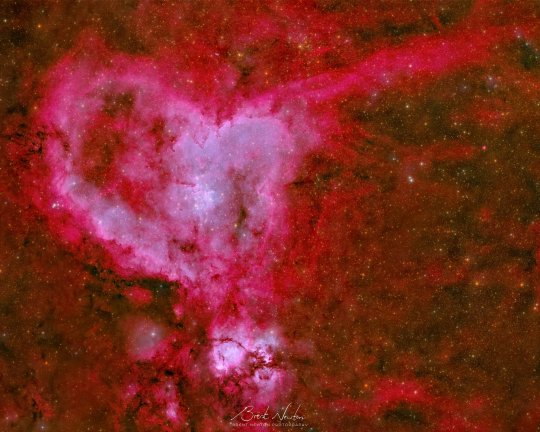
Celestial Conversation Hearts
Communication is key for any relationship – including our relationship with space. Different telescopes are tuned to pick up different messages from across the universe, and combining them helps us learn even more. Roman is designed to see some visible light – the type of light our eyes can see, featured in the photo above from a ground-based telescope – in addition to longer wavelengths, called infrared. That will help us peer through clouds of dust and across immense stretches of space.
Other telescopes can see different types of light, and some detectors can even help us study cosmic rays, ghostly neutrinos, and ripples in space called gravitational waves.
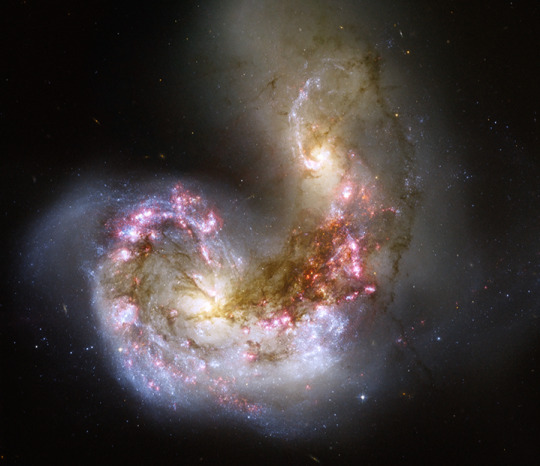
Intergalactic Hugs
This visible and near-infrared image from the Hubble Space Telescope captures two hearts locked in a cosmic embrace. Known as the Antennae Galaxies, this pair’s love burns bright. The two spiral galaxies are merging together, igniting the birth of brand new baby stars.
Stellar nurseries are often very dusty places, which can make it hard to tell what’s going on. But since Roman can peer through dust, it will help us see stars in their infancy. And Roman’s large view of space coupled with its sharp, deep imaging will help us study how galaxy mergers have evolved since the early universe.

Cosmic Chemistry
Those stars are destined to create new chemistry, forging elements and scattering them into space as they live, die, and merge together. Roman will help us understand the cosmic era when stars first began forming. The mission will help scientists learn more about how elements were created and distributed throughout galaxies.
Did you know that U and I (uranium and iodine) were both made from merging neutron stars? Speaking of which…
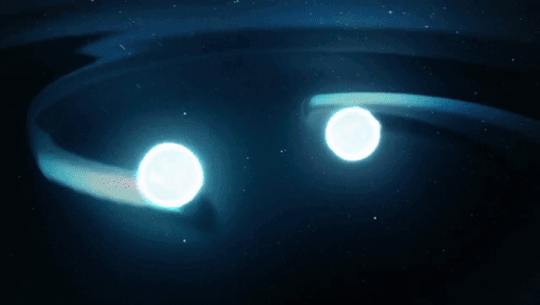
Fatal Attraction
When two neutron stars come together in a marriage of sorts, it creates some spectacular fireworks! While they start out as stellar sweethearts, these and some other types of cosmic couples are fated for devastating breakups.
When a white dwarf – the leftover core from a Sun-like star that ran out of fuel – steals material from its companion, it can throw everything off balance and lead to a cataclysmic explosion. Studying these outbursts, called type Ia supernovae, led to the discovery that the expansion of the universe is speeding up. Roman will scan the skies for these exploding stars to help us figure out what’s causing the expansion to accelerate – a mystery known as dark energy.
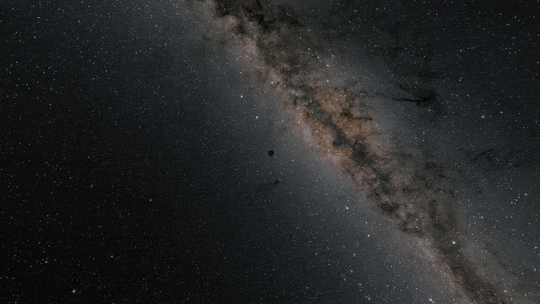
Going Solo
Plenty of things in our galaxy are single, including hundreds of millions of stellar-mass black holes and trillions of “rogue” planets. These objects are effectively invisible – dark objects lost in the inky void of space – but Roman will see them thanks to wrinkles in space-time.
Anything with mass warps the fabric of space-time. So when an intervening object nearly aligns with a background star from our vantage point, light from the star curves as it travels through the warped space-time around the nearer object. The object acts like a natural lens, focusing and amplifying the background star’s light.
Thanks to this observational effect, which makes stars appear to temporarily pulse brighter, Roman will reveal all kinds of things we’d never be able to see otherwise.
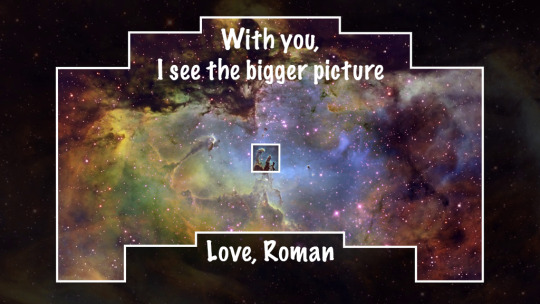
Roman is nearly ready to set its sights on so many celestial spectacles. Follow along with the mission’s build progress in this interactive virtual tour of the observatory, and check out these space-themed Valentine’s Day cards.
Make sure to follow us on Tumblr for your regular dose of space!
#NASA#astronomy#telescope#Roman Space Telescope#Valentine’s Day#space#science#STEM#nebula#chemistry#galaxies#black holes#rogue planets#exoplanets#Hubble Space Telescope#tech
3K notes
·
View notes
Text
All-Star Moments in Space Communications and Navigation
How do we get information from missions exploring the cosmos back to humans on Earth? Our space communications and navigation networks – the Near Space Network and the Deep Space Network – bring back science and exploration data daily.
Here are a few of our favorite moments from 2024.
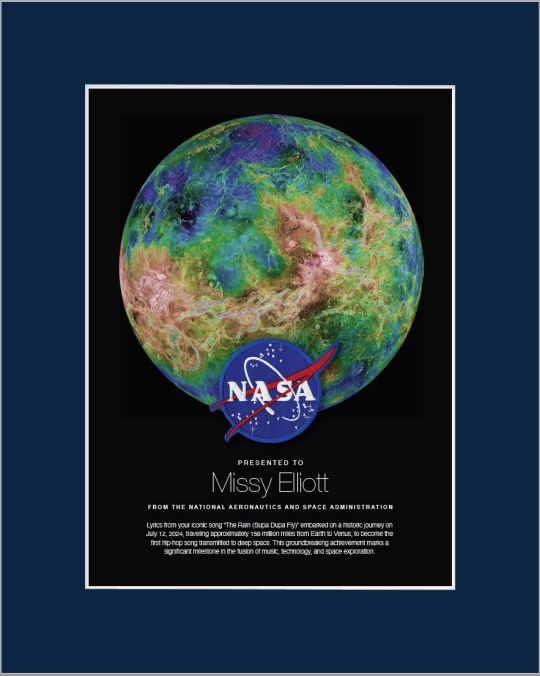
1. Hip-Hop to Deep Space
The stars above and on Earth aligned as lyrics from the song “The Rain (Supa Dupa Fly)” by hip-hop artist Missy Elliott were beamed to Venus via NASA’s Deep Space Network. Using a 34-meter (112-foot) wide Deep Space Station 13 (DSS-13) radio dish antenna, located at the network’s Goldstone Deep Space Communications Complex in California, the song was sent at 10:05 a.m. PDT on Friday, July 12 and traveled about 158 million miles from Earth to Venus — the artist’s favorite planet. Coincidentally, the DSS-13 that sent the transmission is also nicknamed Venus!

NASA's PACE mission transmitting data to Earth through NASA's Near Space Network.
2. Lemme Upgrade You
Our Near Space Network, which supports communications for space-based missions within 1.2 million miles of Earth, is constantly enhancing its capabilities to support science and exploration missions. Last year, the network implemented DTN (Delay/Disruption Tolerant Networking), which provides robust protection of data traveling from extreme distances. NASA’s PACE (Plankton, Aerosol, Cloud, ocean Ecosystem) mission is the first operational science mission to leverage the network’s DTN capabilities. Since PACE’s launch, over 17 million bundles of data have been transmitted by the satellite and received by the network’s ground station.
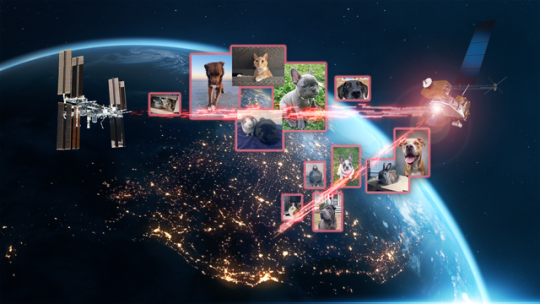
A collage of the pet photos sent over laser links from Earth to LCRD and finally to ILLUMA-T (Integrated LCRD Low Earth Orbit User Modem and Amplifier Terminal) on the International Space Station. Animals submitted include cats, dogs, birds, chickens, cows, snakes, and pigs.
3. Who Doesn’t Love Pets?
Last year, we transmitted hundreds of pet photos and videos to the International Space Station, showcasing how laser communications can send more data at once than traditional methods. Imagery of cherished pets gathered from NASA astronauts and agency employees flowed from the mission ops center to the optical ground stations and then to the in-space Laser Communications Relay Demonstration (LCRD), which relayed the signal to a payload on the space station. This activity demonstrated how laser communications and high-rate DTN can benefit human spaceflight missions.

4K video footage was routed from the PC-12 aircraft to an optical ground station in Cleveland. From there, it was sent over an Earth-based network to NASA’s White Sands Test Facility in Las Cruces, New Mexico. The signals were then sent to NASA’s Laser Communications Relay Demonstration spacecraft and relayed to the ILLUMA-T payload on the International Space Station.
4. Now Streaming
A team of engineers transmitted 4K video footage from an aircraft to the International Space Station and back using laser communication signals. Historically, we have relied on radio waves to send information to and from space. Laser communications use infrared light to transmit 10 to 100 times more data than radio frequency systems. The flight tests were part of an agency initiative to stream high-bandwidth video and other data from deep space, enabling future human missions beyond low-Earth orbit.

The Near Space Network provides missions within 1.2 million miles of Earth with communications and navigation services.
5. New Year, New Relationships
At the very end of 2024, the Near Space Network announced multiple contract awards to enhance the network’s services portfolio. The network, which uses a blend of government and commercial assets to get data to and from spacecraft, will be able to support more missions observing our Earth and exploring the cosmos. These commercial assets, alongside the existing network, will also play a critical role in our Artemis campaign, which calls for long-term exploration of the Moon.

On Monday, Oct. 14, 2024, at 12:06 p.m. EDT, a SpaceX Falcon Heavy rocket carrying NASA’s Europa Clipper spacecraft lifts off from Launch Complex 39A at NASA’s Kennedy Space Center in Florida.
6. 3, 2, 1, Blast Off!
Together, the Near Space Network and the Deep Space Network supported the launch of Europa Clipper. The Near Space Network provided communications and navigation services to SpaceX’s Falcon Heavy rocket, which launched this Jupiter-bound mission into space! After vehicle separation, the Deep Space Network acquired Europa Clipper’s signal and began full mission support. This is another example of how these networks work together seamlessly to ensure critical mission success.

Engineer Adam Gannon works on the development of Cognitive Engine-1 in the Cognitive Communications Lab at NASA’s Glenn Research Center.
7. Make Way for Next-Gen Tech
Our Technology Education Satellite program organizes collaborative missions that pair university students with researchers to evaluate how new technologies work on small satellites, also known as CubeSats. In 2024, cognitive communications technology, designed to enable autonomous space communications systems, was successfully tested in space on the Technology Educational Satellite 11 mission. Autonomous systems use technology reactive to their environment to implement updates during a spaceflight mission without needing human interaction post-launch.

A first: All six radio frequency antennas at the Madrid Deep Space Communication Complex, part of NASA’s Deep Space Network (DSN), carried out a test to receive data from the agency’s Voyager 1 spacecraft at the same time.
8. Six Are Better Than One
On April 20, 2024, all six radio frequency antennas at the Madrid Deep Space Communication Complex, part of our Deep Space Network, carried out a test to receive data from the agency’s Voyager 1 spacecraft at the same time. Combining the antennas’ receiving power, or arraying, lets the network collect the very faint signals from faraway spacecraft.
Here’s to another year connecting Earth and space.
Make sure to follow us on Tumblr for your regular dose of space!
1K notes
·
View notes